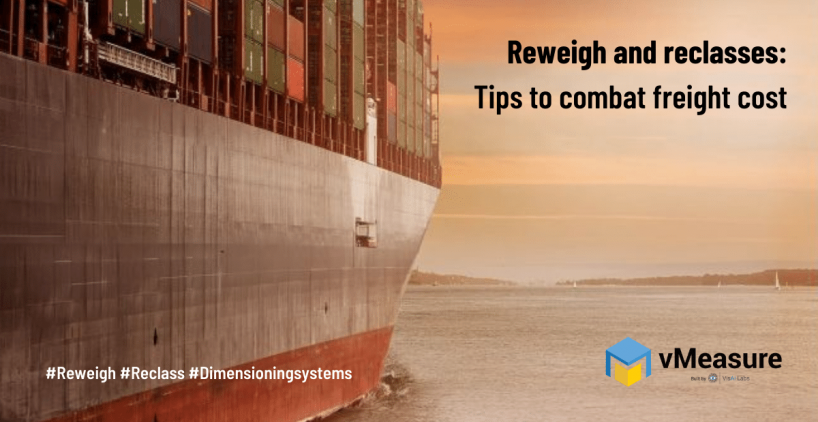Summary
Reweigh and reclass play a bigger role in the LTL shipping market.
However, the increased DIM-based pricing structure often makes the freight reweigh and reclasses a serious topic of concern.
In this blog post, you will learn more about reweighing and reclassifying and how carriers and shippers can eliminate them by deploying automated dimensioning systems.
Introduction
Unbelievably, the phrase “reweigh fee” is the LTL carriers’ and shippers’ worst fear. Yet why? Here is a prime illustration: Consider a scenario in which you have completed all the shipment-specific checklist items, such as ensuring the packages are properly packaged, maintaining accurate paperwork, verifying the shipping address, and enabling package documentation, and your products have now arrived at their destination.
It’s time to get your bills, and you’re shocked to see that one of them is about $200, which is double what you had anticipated. When you double-check the cause of extra expenses, you find that dimensional errors costing you more fees on top of the reweigh fees are to blame. But can you deduce what transpired?
Carriers and shippers are surely familiar with this scenario because freight reweighs are becoming increasingly common, particularly now that FedEx and UPS have adopted a DIM-based pricing model. However, for many of us and eCommerce shippers alike, this price structure would be both a blessing and a calamity. Due to a mismatch between the product and packaging sizes in one instance (packing small-sized items in large boxes), shippers and eCommerce shippers were obliged to lower packaging sizes, which increased shipping costs. To put it another way, nobody likes to spend more bucks!
So what exactly are reweigh and reclasses?
When a carrier inspects and weighs a product during shipment and the weight listed on the BOL (Bill of Landing), and the actual weight does not match, the package is reweighed. Therefore, one of the key elements used to determine freight prices is weight, which frequently affects freight class.
When the carrier looks at the freight while it is in transit and realizes that the class listed on the bill of lading does not correspond to the actual class, the freight is reclassified.
How can LTL reweighs and classifications be eliminated?
It’s trickier than it looks to choose the proper freight class for your less-than-truckload (LTL) shipments. However, freight shipping classes give all businesses a consistent way to measure freight of various sizes and weights.
The National Motor Freight Classification (NMFC) uses four key metrics to define a commodity’s shipping class:
Density
The weight and size of a product influence its density. Lower classes and lower prices are associated with higher density. At first look, this could appear backward, but consider that shipping companies prefer big freight that doesn’t require much space relative to its weight. As a result, they can load more goods on their vehicle, which increases their revenue.
Handling
Refers to the item’s capability to be handled when moving freight from one LTL terminal to another. The size, fragility, and packaging of an object impact how difficult it is to handle.
Liability
Refers to the possibility of your freight being damaged, stolen, or mishandled. When cargo undergoes an explosion, spontaneous combustion perishes, or breaks, there is a greater monetary liability.
Stowability
Stowability is the ability of the shipment to fit inside the transport vehicle with other cargo. As a general rule, consider how well an item may be “stowed” or transported compared to other items.
So, here are a few strategies that carriers and shippers can use to eliminate reweigh and reclasses like a shot:
Pack precisely
To ensure that all information is comprehensive and accurate, specify what you are shipping and how it is transported. Even when the freight is identical, shipping on a pallet and shipping in a box may fall under two separate freight classes. You can calibrate parcel dims with extreme accuracy by implementing equipment like vMeasure automated dimensioning systems. Therefore, the next time you consider measuring correct parcel information, vMeasure dimensioning systems may be a better choice for your company.
Measure accurately
Take precise measurements of your freight and pallet. The best action to take would be to measure the specific package being used, as a “typical” package could refer to a wide range of sizes. A few inches off could force categorization of the freight. Remember, every inch counts! To take exact parcel measurements, you can take advantage of dimensioning systems to effortlessly dimension, weigh, scan and capture parcel images all in one go! Regarding the results, the dimensioning systems are more accurate than manual dimensioning methods.
Ensure your entire shipment is weighed
Weigh your entire LTL shipment to prevent rounding up or down, which can change the package’s freight class. Carriers measure the weight and dimensions of your freight using precise digital scales and high-tech laser or computer vision-based dimensioning systems. Ensure your measurements are precise beforehand to prevent a sudden change in shipping class from costing you time and money.
Calculate the density of your shipment
Be sure to determine the density of your shipment when necessary. When it comes to goods with a wide range of weights, such as machinery or car parts, the shipping class is determined by the density of your freight. Finding the appropriate freight shipping class for your shipment will be easier if you know how your commodity will be categorized and provide a precisely estimated density.
Leverage a 3PL
You must determine the density based on the dimensions and weight of your package. The freight’s density determines the shipping class for some items with a wide range of weights, like machinery or auto components. Therefore, you need to know how your item will be classified and provide an accurate estimate of its density to choose the right freight shipping class for your shipment.
Conclusion
Even if you believe everything is in order, freight transportation occasionally brings unpleasant shocks. While intentionally trying to deceive a carrier or taking shortcuts to save a few dollars is never a smart idea, even careful shippers sometimes encounter unintended costs. Freight reweighs, and reclassses shouldn’t be one of them. Furthermore, deploying the right dimensioning systems in your workspace can greatly benefit in eliminating DIM-specific errors and pointless shipping expenses.



